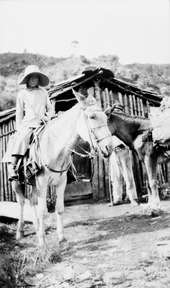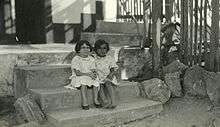Mary Agnes Chase
| Mary Agnes Chase | |
|---|---|
%2C_sitting_at_desk_with_specimens.jpg) Mary Agnes Chase seated at a desk with herbarium sheets, c.1960 [1] | |
| Born |
April 29, 1869 Iroquois County, Illinois |
| Died | September 24, 1963 (aged 94) |
| Other names | Agnes Chase |
| Nationality | American |
| Fields | botany, botanical illustration |
| Institutions | U.S. Department of Agriculture, Smithsonian Institution |
| Known for | First Book of Grasses |
| Author abbrev. (botany) | Chase |
| Spouse | William Ingraham Chase |
Mary Agnes Meara Chase (April 29, 1869 – September 24, 1963) was an American botanist who worked at the U.S. Department of Agriculture and the Smithsonian Institution. She is "considered one of the world's outstanding agrostologists"[2][3] and is known for her work on the study of grasses and for her work as a suffragist.
Life and career

Chase was born in Iroquois County, Illinois and held no formal education beyond grammar school. Chase made significant contributions to the field of botany, authored over 70 scientific publications, and was conferred with an honorary doctorate in science from the University of Illinois.[2] She specialized in the study of grasses and conducted extensive field work in North and South America. Her field books from 1897 to 1959 are archived in the Smithsonian Institution Archives.
In 1901, Chase became a botanical assistant at the Field Museum of Natural History under Charles Frederick Millspaugh, where her work was featured in two museum publications: Plantae Utowanae (1900) and Plantae Yucatanae (1904).[5] Two years later, Chase joined the U.S. Department of Agriculture (USDA) as a botanical illustrator and eventually became a scientific assistant in systematic agrostology (1907), assistant botanist (1923), and associate botanist (1925), all under Albert Spear Hitchcock. Chase worked with Hitchcock for almost twenty years, collaborating closely and also publishing (The North American Species of Panicum [1910]).[2]
Following Hitchcock's death in 1936, Chase succeeded him to become senior botanist in charge of systematic agrostology and custodian of the Section of Grasses, Division of Plants at the United States National Museum (USNM). Chase retired from the USDA in 1939 but continued her work as custodian of the USNM grass herbarium until her death in 1963.
Women's Suffrage Movement

Chase experienced discrimination based on her gender in the scientific field, for example, being excluded from expeditions to Panama in 1911 and 1912 because the expedition's benefactors feared the presence of women researchers would distract men.[7] During World War I, Chase marched with Alice Paul and was jailed several times for her activities. In 1918, she was arrested at the Silent Sentinels rally picketing the White House; she refused bail and was held for 10 days, where she instigated a hunger-strike and was force-fed.[7] The USDA accused her of "conduct unbecoming a government employee," but Hitchcock helped her keep her job.[8]
Chase was also an active member of the National Association for the Advancement of Colored People (NAACP).[9]
Awards and Honors
- 1956, Certificate of Merit from the Botanical Society of America[10]
- 1958, Honorary doctorate from the University of Illinois [10]
- 1959, Honorary Fellow from the Smithsonian Institution [10]
- 1961, Fellow from the Linnean Society of London [10]
Selected Works
| Library resources about Mary Agnes Chase |
| By Mary Agnes Chase |
|---|
- 1922, First book of grasses: The structure of grasses explained for beginners. New York: The Macmillan Company. OCLC 811997103
- 1950, revision, Manual of grasses of the United States. Washington, D.C.: U.S. Dept. of Agriculture. OCLC 847512944
- 1962, with Cornelia D. Niles, Index to Grass Species. Boston: G.K. Hall. OCLC 577875
Eponyms
References
- ↑ "Mary Agnes Chase, Botanist". Smithsonian Institution Archives. Smithsonian Institution. Retrieved 9 July 2013.
- 1 2 3 "Historical note". SIA RU000229, United States National Museum Division of Grasses, Records, 1884, 1888, 1899-1965. Smithsonian Institution Archives. Retrieved 9 July 2013.
- ↑ Chase, Agnes; A.S. Hitchcock (1910). "The North American species of Panicum,". Bulletin (United States National Museum). doi:10.5962/bhl.title.53687.
- ↑ "Mary Agnes Chase Collecting Plants, Brazil". Smithsonian Institution Archives. Smithsonian Institution. Retrieved 9 July 2013.
- ↑ Carol Hurd Green, ed. (1980). Sicherman, Barbara, ed. Notable American women: The modern period: A biographical dictionary. Harvard University Press. pp. 146–148.
- ↑ IPNI. Chase.
- 1 2 Adams, Katherine H.; Michael L. Keene (2010). After the vote was won: The later achievements of fifteen suffragists. McFarland. pp. 73–74.
- ↑ Henson, Pamela M. (2003). "'What holds the earth together': Agnes Chase and American agrostology". Journal of the History of Biology. 36 (3): 437–460. doi:10.1023/b:hist.0000004568.11609.2d.
- ↑ Wedin, Walter F.; Steven L. Fales (2009). Grassland: Quietness and Strength for a New American Agriculture. Madison, WI.
- 1 2 3 4 The biographical dictionary of women in science, Vol. 1. Routledge. 2000. pp. 246–247.
- ↑ Novon 3(3): 306 (1993). (IK)
Bibliography
- Grinstein, Louise S.; Carol A. Biermann; Rose K. Rose (1997). Women in the biological sciences: a biobibliographic sourcebook. Westport, CT: Greenwood Press.
- Henson, Pamela M (2002). "Invading Arcadia: Women scientists in the field in Latin America, 1900-1950". The Americas. 58 (4): 577–600. doi:10.1353/tam.2002.0045. JSTOR 1007799.
- Wedin, Walter F.; Steven L. Fales (2009). Grassland: Quietness and Strength for a New American Agriculture. Madison, WI.
External links
- Biography of Mary Agnes Chase from the National Museum of Natural History's Department of Anthropology
- The Hitchcock-Chase Collection at Carnegie Mellon University's Hunt Institute for Botanical Documentation
- Photographs from Mary Agnes Chase's field books from the Smithsonian Institution Archives
- United States National Museum Division of Grasses, Records, 1884, 1888, 1899-1965 from the Smithsonian Institution Archives
| Wikimedia Commons has media related to Mary Agnes Chase. |